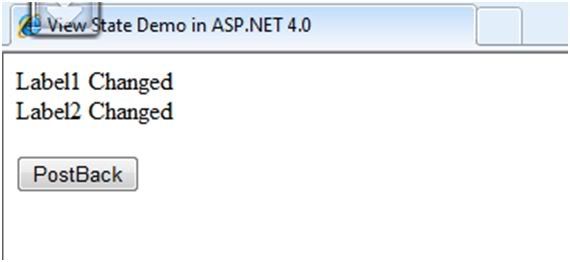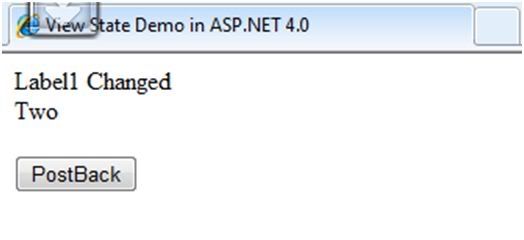What's New in ASP.NET 4.0 – Better ViewState Control
In ASP.NET 2.0/3.5, you could disable ViewState for individual controls. However what you could not do is disable ViewState at a Page level and then enable it individually for controls on that page that require it. ASP.NET 4.0 changes that and gives more control to developers.
ASP.NET 4.0 introduces the ViewStateMode property that lets you disable ViewState at a Parent level and then enable it for the child controls that require it.
Let’s see this with an example. We will first create a page in ASP.NET 3.5 and disable ViewState on the Parent level and then observe the behavior of ViewState in child controls. We will then use the same example in ASP.NET 4.0 using the ViewStateMode property and observe the changes.
ViewState in ASP.NET 2.0/3.5
Create an ASP.NET application. Place two Label controls and one Button control on the page. Now disable view state on the Page by setting the ‘EnableViewState’ property to false. On the first Label control, set ‘EnableViewState’ property to true as shown below:
<%@ Page Language="C#" AutoEventWireup="true" CodeFile="Default.aspx.cs"
EnableViewState="false" Inherits="_Default" %>
DOCTYPE html PUBLIC "-//W3C//DTD XHTML 1.0 Transitional//EN" "http://www.w3.org/TR/xhtml1/DTD/xhtml1-transitional.dtd">
<html xmlns="http://www.w3.org/1999/xhtml">
<head runat="server">
<title>ViewState Demo in ASP.NET 3.5title>
head>
<body>
<form id="form1" runat="server">
<div>
<asp:Label ID="Label1" runat="server" Text="One" EnableViewState="true">asp:Label><br />
<asp:Label ID="Label2" runat="server" Text="Two">asp:Label><br /><br />
<asp:Button ID="Button1" runat="server" Text="PostBack" />
div>
form>
body>
html>
In the code behind file, write the following code which set’s the text of the Label controls:
C#
protected void Page_Load(object sender, EventArgs e)
{
if (!IsPostBack)
{
Label1.Text = "Label1 Changed";
Label2.Text = "Label2 Changed";
}
}
VB.NET
Protected Sub Page_Load(ByVal sender As Object, ByVal e As EventArgs)
If (Not IsPostBack) Then
Label1.Text = "Label1 Changed"
Label2.Text = "Label2 Changed"
End If
End Sub
Now what is ‘ideally’ expected out of this setup is that although ViewState is disabled for the entire page, yet Label1 should save ViewState and retain its new value ‘Label1 Changed’ after postback; since ViewState is explicitly enabled on it.
Run the application.
Before PostBack

After PostBack

You will observe that on hitting the button (causing a postback), Label1 does not retain the value (Label1 Changed) explicitly set on it. Not as we expected!
ViewState in ASP.NET 4.0
We will now create a similar web application in ASP.NET 4.0. The only difference is that here we will use the new ‘ViewStateMode’ property.
The ViewStateMode property accepts three values: Enabled, Disabled, andInherit.
Enabled - enables view state for that control and any child controls that are set to ‘Inherit’ or that have nothing set.
Disabled - disables view state
Inherit - specifies that the control uses the ViewStateMode setting from the parent control.
The markup looks similar to the following:
<%@ Page Language="C#" AutoEventWireup="true" CodeFile="Default.aspx.cs"
ViewStateMode="Disabled" Inherits="_Default" %>
DOCTYPE html PUBLIC "-//W3C//DTD XHTML 1.0 Transitional//EN" "http://www.w3.org/TR/xhtml1/DTD/xhtml1-transitional.dtd">
<html xmlns="http://www.w3.org/1999/xhtml">
<head id="Head1" runat="server">
<title>View State Demo in ASP.NET 4.0title>
head>
<body>
<form id="form1" runat="server">
<div>
<asp:Label ID="Label1" runat="server" Text="One" ViewStateMode="Enabled">asp:Label><br />
<asp:Label ID="Label2" runat="server" Text="Two">asp:Label> <br /><br />
<asp:Button ID="Button1" runat="server" Text="PostBack" />
div>
form>
body>
html>
Observe that ViewStateMode on the Page is set to Disabled. The child Label1 control has ViewStateMode set to Enabled, so Label1 ‘ideally’ should save view state. Since the ViewStateMode property is not set on Label2 , so the Label2 control inherits this property value from its parent (Page) and therefore saves no view state.
Note: The default value of ViewStateMode is Enabled for Pageobject. The default value of ViewStateMode is Inherit for controls.
Run the application and hit the button. What do you expect now?
When the page first loads, both the Label controls display the text as set in the codebehind file.
Before PostBack

However, after hitting the button and causing a postback, Label1 does retain its value as we had expected!
After PostBack

This is a welcome change as now we can disable ViewState on a parent level and enable it only for those child controls that require it. This improves performance with lesser efforts and gives us more control. This was however just a demo. You will realize maximum advantage of this new feature in a Master-Content page scenario by setting ViewStateMode to Disabled for the Master page and then enable it individually in Content Pages, or individually on controls that require view state.

0 comments:
Post a Comment